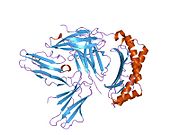HLA-G
HLA-G histocompatibility antigen, class I, G, also known as human leukocyte antigen G (HLA-G), is a protein that in humans is encoded by the HLA-G gene.[5]
HLA-G belongs to the HLA nonclassical class I heavy chain paralogues. This class I molecule is a heterodimer consisting of a heavy chain and a light chain (beta-2 microglobulin). The heavy chain is anchored in the membrane. HLA-G is expressed on fetal derived placental cells. The heavy chain is approximately 45 kDa and its gene contains 8 exons. Exon one encodes the leader peptide, exons 2 and 3 encode the alpha1 and alpha2 domain, which both bind the peptide, exon 4 encodes the alpha3 domain, exon 5 encodes the transmembrane region, and exon 6 encodes the cytoplasmic tail.[5]
Function
HLA-G may play a role in immune tolerance in pregnancy, being expressed in the placenta, while the classical MHC class I genes HLA-A and HLA-B are not.[6] HLA-A and -B downregulation results in protection from cytotoxic T cell responses, but would in theory result in a missing self response by natural killer cells. HLA-G is a ligand for NK cell inhibitory receptor KIR2DL4, and therefore expression of this HLA by the trophoblast defends it against NK cell-mediated death.[7]
However, a big family with several members bearing only "null" HLA-G alleles has been found. None of these homozygous subjects have pregnancy or birth difficulties; nor do they present immunodeficiencies, autoimmune diseases, or tumors.[8][9] It is striking that this "null" allele (HLA-G*01:05N), while it is quite frequent in some populations, like in Iranians, it is almost absent in some Amerindian populations.[10] Also, some higher primates do not show all MHC-G isoforms.[11] In addition, Cercopithecinae middle-sized Old World monkeys do not bear full MHC-G molecules since all of these monkeys present stop codons at MHC-G DNA.[12] All of these anomalies must be studied.
The presence of soluble HLA-G (sHLA-G) in embryos is associated with better pregnancy rates. In order to optimize pregnancy rates, there is significant evidence that a morphological scoring system is the best strategy for the selection of embryos.[13] However, presence of soluble HLA-G might be considered as a second parameter if a choice has to be made between embryos of morphologically equal quality.[13]
Interactions
HLA-G has been shown to interact with CD8A.[14][15]
References
- ^ a b c ENSG00000233095, ENSG00000237216, ENSG00000276051, ENSG00000204632, ENSG00000235346, ENSG00000235680, ENSG00000206506 GRCh38: Ensembl release 89: ENSG00000230413, ENSG00000233095, ENSG00000237216, ENSG00000276051, ENSG00000204632, ENSG00000235346, ENSG00000235680, ENSG00000206506 – Ensembl, May 2017
- ^ a b c GRCm38: Ensembl release 89: ENSMUSG00000016206 – Ensembl, May 2017
- ^ "Human PubMed Reference:". National Center for Biotechnology Information, U.S. National Library of Medicine.
- ^ "Mouse PubMed Reference:". National Center for Biotechnology Information, U.S. National Library of Medicine.
- ^ a b "Entrez Gene: HLA-G HLA-G histocompatibility antigen, class I, G".
- ^ Jay Iams; Creasy, Robert K.; Resnik, Robert; Robert Reznik (2004). Maternal-fetal medicine. Philadelphia: W.B. Saunders Co. pp. 31–32. ISBN 0-7216-0004-2.
- ^ Lash, G, Robson, S, Bulmer, J. (2010). "Review: Functional role of uterine natural killer (uNK) cells in human early pregnancy decidua". Placenta. 31 (S): 87–92. doi:10.1016/j.placenta.2009.12.022. PMID 20061017.
{{cite journal}}: CS1 maint: multiple names: authors list (link) - ^ Suárez MB, Morales P, Castro MJ, Fernández V, Varela P, Alvarez M, Martínez-Laso J, Arnaiz-Villena A (1997). "A new HLA-G allele (HLA-G*0105N) and its distribution in the Spanish population". Immunogenetics. 45 (6): 464–5. doi:10.1007/s002510050235. PMID 9089111.
- ^ Casro MJ, Morales P, Rojo-Amigo R, Martinez-Laso J, Allende L, Varela P, Garcia-Berciano M, Guillen-Perales J, Arnaiz-Villena A (September 2000). "Homozygous HLA-G*0105N healthy individuals indicate that membrane-anchored HLA-G1 molecule is not necessary for survival". Tissue Antigens. 56 (3): 232–9. doi:10.1034/j.1399-0039.2000.560305.x. PMID 11034559.
- ^ Arnaiz-Villena A, Enriquez-de-Salamanca M, Areces C, Alonso-Rubio J, Abd-El-Fatah-Khalil S, Fernandez-Honrado M, Rey D (April 2013). "HLA-G(∗)01:05N null allele in Mayans (Guatemala) and Uros (Titikaka Lake, Peru): Evolution and population genetics". Hum. Immunol. 74 (4): 478–82. doi:10.1016/j.humimm.2012.12.013. PMID 23261410.
- ^ Castro MJ, Morales P, Martinez-Laso J, Allende L, Rojo-Amigo R, Gonzalez-Hevilla M, Varela P, Moscoso J, Garcia-Berciano M, Arnaiz-Villena A (November 2000). "Lack of MHC-G4 and soluble (G5, G6) isoforms in the higher primates, Pongidae". Hum. Immunol. 61 (11): 1164–8. doi:10.1016/s0198-8859(00)00189-0. PMID 11137222.
- ^ Castro MJ, Morales P, Fernández-Soria V, Suarez B, Recio MJ, Alvarez M, Martín-Villa M, Arnaiz-Villena A (1996). "Allelic diversity at the primate Mhc-G locus: exon 3 bears stop codons in all Cercopithecinae sequences". Immunogenetics. 43 (6): 327–36. doi:10.1007/bf02199801. PMID 8606053.
- ^ a b Rebmann V, Switala M, Eue I, Grosse-Wilde H (May 2010). "Soluble HLA-G is an independent factor for the prediction of pregnancy outcome after ART: a German multi-centre study". Hum Reprod. 25 (7): 1691–8. doi:10.1093/humrep/deq120. PMID 20488801.
- ^ Gao GF, Willcox BE, Wyer JR, Boulter JM, O'Callaghan CA, Maenaka K, Stuart DI, Jones EY, Van Der Merwe PA, Bell JI, Jakobsen BK (May 2000). "Classical and nonclassical class I major histocompatibility complex molecules exhibit subtle conformational differences that affect binding to CD8alphaalpha". J. Biol. Chem. 275 (20): 15232–8. doi:10.1074/jbc.275.20.15232. PMID 10809759.
{{cite journal}}: CS1 maint: unflagged free DOI (link) - ^ Sanders SK, Giblin PA, Kavathas P (September 1991). "Cell-cell adhesion mediated by CD8 and human histocompatibility leukocyte antigen G, a nonclassical major histocompatibility complex class 1 molecule on cytotrophoblasts". J. Exp. Med. 174 (3): 737–40. doi:10.1084/jem.174.3.737. PMC 2118947. PMID 1908512.
Further reading
- Carosella ED, Favier B, Rouas-Freiss N, Moreau P, LeMaoult J (2008). "Beyond the increasing complexity of the immunomodulatory HLA-G molecule". Blood. 111 (10): 4862–70. doi:10.1182/blood-2007-12-127662. PMID 18334671.
- Carosella ED, Moreau P, LeMaoult J, Rouas-Freiss N (2008). "HLA-G: From biology to clinical benefits". Trends in Immunology. 29 (3): 125–32. doi:10.1016/j.it.2007.11.005. PMID 18249584.











